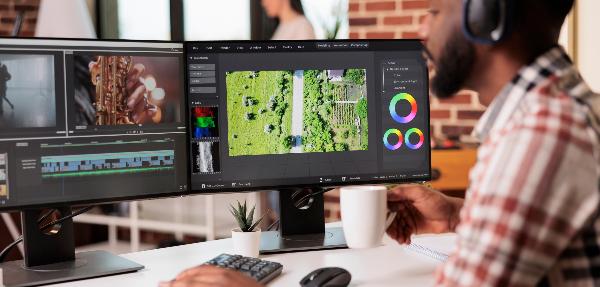How to Sync Music Audio and Visuals Easily: A Guide for Wedding Video Editors

Strong 8k brings an ultra-HD IPTV experience to your living room and your pocket.
Filming an excellent and engaging music video entails coordination of technical prowess and creativity. No matter if you are working as an experienced professional or as a beginner aiming to become a wedding video editor, there is no doubt that learning how to sync music to the video can be very important. In this guide, the main focus will be on the technical and creative sides of this process to share strategies for improving your wedding video editing services.
Understanding the Rhythm in Music
At the heart of every extraordinary music video, there is always that specific element of the rhythm. For any wedding film editor, the first thing that concerns him or her is the music he or she has on hand. Listen to the track, several times, focusing on the rhythm, tempo, and dynamics. This familiarity will enable you to determine when changes in visuals can be made to transform the impact of the music.
Considering Technical Factors of Syncing
1. Frame Rates and Timecodes
It is also critical to comprehend frame rates and timecodes to ensure precise synchronization between different clips. Make sure that your video clip has the same frame rate as the audio track that is associated with it, considering typical frame rates are 24, 25, and 30 frames per second (fps). Maintaining coherent frame rates helps avoid sync problems and results in seamless video streaming.
2. Choose Right Editing Software
It is also important to correctly select the software for editing because it defines how convenient the sync will be. The most commonly used software for wedding videos are Adobe Premiere, Final Cut Pro X, and DaVinci Resolve. These programs provide strong correlation features for accurate positioning of the audio and video streams, which is suitable for intricate work.
Consider Creative Elements of Syncing
1. Storytelling Through Music
When editing a wedding video, the primary purpose of a video editor is to tell a story that will evoke the audience’s emotions. Maneuver the storyline and utilize the music so that the changes in the scene correspond to musical changes. For example, the increasing intensity of music can be synchronized with action scenes in the video, and melodic and gentle passages can be used for scenes that depict love moments.
2. Visual Pacing
Rhythm is one of the critical factors that help in producing a cohesiveness of the music video. Timing is critical; ensure the cuts are coordinated with the beats per minute. A quick rhythm may need sharp editing and violent movements of the camera while a slow beat would suit long takes and rather more reflective shots. This alignment makes sure that the visuals are in tune with the working beat of the track.
Tips for Wedding Video Editing
1. Mark Key Moments
Using markers, identify important milestones in the music and align them with the corresponding moments in the visuals. This technique helps one to synchronize perfectly and also maintain a uniform pattern if it is being recorded.
2. Use Transitions Wisely
Transitional can be a key event that disrupts the consistent steady pace and tempo of a typical music video. Being an outsourced wedding video editing expert, try using different transition types, including cross-dissolves, cuts, and wipes, and see which one fits well with the chosen music. Make sure that transitions complement the viewing by improving the flow of content without interrupting the music.
3. Syncing Lip Movements
If, for example, your wedding film includes speeches or singing, it is essential to synchronize the motions of the lips with the voice. This process does take some hours but is very important if one wants a professional-looking product. With regards to this, you should sync to the audio waveform by aligning the positive and negative phases with the lip movements in the video.
Tools and Techniques
1. Beat Matching
Synchronization or beat matching can be defined as the process of ensuring that the visual cuts made on the music video are made in time with the beats of the song. Most of the editing software applications come with features that can help the user identify beats in particular audio. Some tools exist and can be used to place markers and guarantee that cuts of the video correspond to the pace of the song that is being played.
2. Audio Waveform Analysis
By inspecting the audio waveform, it will be possible to gain insights into the structure of the music. Waveform analysis can also be used to search for moments and turnarounds to make key decisions on when exactly this is needed. This analysis is useful in making very fine-tuned adjustments to the sound-video synchronization to improve them.
Implementation Advanced Techniques
1. Dynamic Editing
Dynamic editing mainly centers on the ability to change the rates and speed of your cuts to the changing beat patterns within the audio. For example, a decrease of volume can be associated with slow motion while the increase of tempo can be connected to fast motion or sudden changes in the camera observations or shots.
2. Motion Graphics and Effects
It is mostly possible to add extra synching if you include motion graphics and some visual effects. These elements should be used to draw the viewer’s attention to specific musical cues, therefore providing a visual spectacle. Effects such as animated text or visual flares can support the music, highlight certain points in a musical composition, and enrich the production.
Common Challenges and Solutions
1. Dealing with Sync Drift
Drift means that the audio and video become gradually out of phase with each other, and a typical example is sync drift. This issue can occur because of various values of frame rates or when initial alignment is not fully accurate. Timing issues must be fixed by continually monitoring the timing during the recording of the video and correcting it accordingly. This way, slight changes are much less likely to cause the process to be seen as drifting.
2. Managing Audio Quality
Sometimes, if audio and visual elements are not in harmony, an unpleasant sound can ruin a beautiful picture in a music video. When editing the videos for the wedding video and from the wedding rehearsal, make sure that the audio of the video is clear to prevent distortion and background noise. Editing tools should then be employed to adjust and filter the audio depending on the requirements.
3) Outsourced Wedding Video Editing
Outsourced wedding video editing services must be made in a way that the vendor appreciates the value of music and video synchrony. This shows that proper communication and the provision of comprehensive briefs assist in setting the correct expectations required to attain the correct result. Make sure the providers have an impressive portfolio in creating and shooting high-quality and well-coordinated wedding videos.
Conclusion
Ensuring an excellent coordination of music with the related images is not only a question of technology but also creativity. It shows how to communicate and translate the basic beat and rhythm, absorb technicalities, and use your creative sense to produce music videos that blend and stick nicely, intensify the intended message, and move the audience. Therefore, no matter if you are an editor in a particular company engaged in videography or a company which provides services for wedding videography, following these tips and employing these techniques will enable you to offer your clients stunning videos.
SourceLink[https://frobotstudios.com/2024/07/05/how-to-sync-music-audio-and-visuals-easily-a-guide-for-wedding-video-editors/]
Note: IndiBlogHub features both user-submitted and editorial content. We do not verify third-party contributions. Read our Disclaimer and Privacy Policyfor details.


